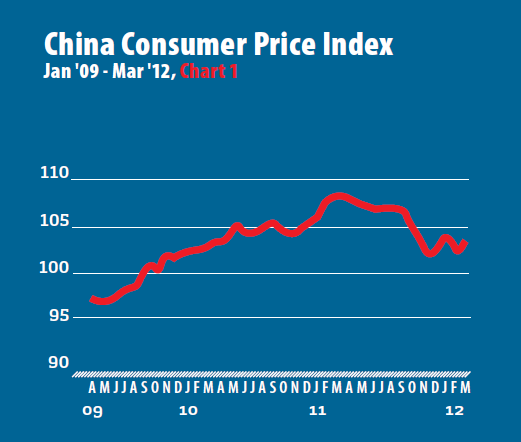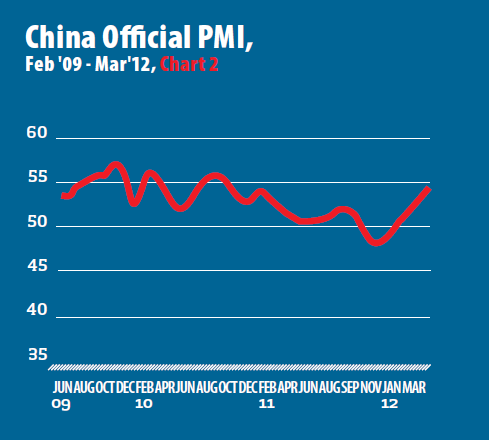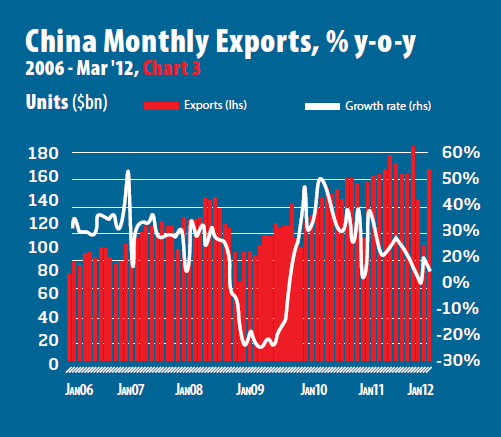|

Focus on Maintaining Growth
Inflation in China rose in March, with the Consumer Price Index (CPI) up 3.6 percent compared with a year earlier, well above the 3.2 percent registered in February (see Chart 1). The rise in inflation can be attributed to a spike in prices for food, which rose by 7.5 percent and makes up a large chunk of household spending and is subsequently closely monitored by authorities. The price of pork for example, rose 11.3 percent year on year, while fresh vegetable prices rose 20.5 percent. Analysts point to rising labor costs, an unusually cold and rainy spring, and reduced crop sizes, for higher vegetable prices. However, prices are expected to trend lower and stabilize in the months ahead, with the CPI staying comfortably below the government's official target of 4 percent, which will leave more room for policy manoeuvring. Overall, China's inflation rate averaged 3.8 percent in the first quarter as China's policymakers shifted their attention toward steering a soft landing of the economy.

Manufacturing maintains momentum
China's manufacturing activity maintained its momentum in March, with the official Purchasing Managers' Index (PMI) rising to 53.1, an 11-month high, and an increase of 2.1 percentage points over February (see Chart 2). As a level of 50 demarcates expansion from contraction, it marked the fourth-straight month manufacturing activity has stayed in expansionary territory. However, even though analysts are pointing out March's PMI rise is weaker than the historical average after accounting for seasonal changes (factories ramp up production when the winter season ends), the latest PMI reading nonetheless signals that China's economy is less likely to experience a hard landing. The March PMI reading also showed a broad rebound in production, with seemingly strong domestic demand pushing the new orders sub-index to 55.1 in March, up from February's 51. However, demand for Chinese products overseas was not as robust, with the sub-index for new export orders rising to 51.9, slightly up from February's 51.1.

Trade surplus returns
China export-led trade surplus returned in March, as exports grew faster than expected, including a 10.5 year-on-year increase in exports to the United States. China registered a monthly trade surplus of $5.35 billion in March, in stark contrast to a decade-high trade deficit of about $31.5 billion recorded in February. Meanwhile, exports to the EU decreased by 3.1 percent from March last year, while total exports from China rose a faster-than-expected 8.9 percent, reaching $165.66 billion (see Chart 3). Imports grew by only 5.3 percent year on year to reach $160.31 billion, the weakest rate since imports shrunk by 15.3 percent in January. For the first quarter, China registered a small trade surplus of $670 million, versus a $2.2 billion trade deficit in the first quarter of 2011, indicating a positive contribution to GDP growth.
Economy expands in Q1
Growth in China's gross domestic product slowed to 8.1 percent year on year in the first quarter of 2012, the country's lowest rate of economic growth since the first quarter of 2009, mostly due to a slowdown in exports and real-estate investment.
The first quarter also saw a shift in GDP growth, with consumption by households and government contributing 76 percent of first quarter growth, up sharply from 51.6 percent in 2011 and from an average of 41.5 percent in the last decade. The government has repeatedly expressed its ambitions to rebalance China's economic growth mode and for consumption to play a bigger role in the economy. Some of the measures the government has thus far taken include increasing the minimum wage to promote income growth and boost the purchasing power of ordinary citizens. Overall, although China's GDP growth slowed from the 8.9 percent registered in the fourth quarter of 2011, it still remains above the 7.5 percent target set by the government earlier in the year.
|